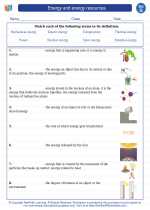Kinetic Energy
Kinetic energy is the energy an object possesses due to its motion. It is a scalar quantity, which means it only has magnitude and no direction. The kinetic energy of an object depends on its mass and its velocity. The formula to calculate kinetic energy is:
KE = 0.5 * m * v2
Where:
KE = Kinetic Energy
m = Mass of the object
v = Velocity of the object
Factors Affecting Kinetic Energy:
1. Mass: The kinetic energy of an object increases with its mass. A heavier object, when moving at the same velocity as a lighter object, will have more kinetic energy.
2. Velocity: The kinetic energy of an object increases with the square of its velocity. This means that doubling the velocity will quadruple the kinetic energy.
Units of Kinetic Energy:
The SI unit of kinetic energy is the joule (J). It can also be expressed in terms of kilojoules (kJ) or in non-SI units such as calories or foot-pounds.
Applications of Kinetic Energy:
Kinetic energy is involved in various real-life situations, including:
- The energy of moving vehicles
- The energy of wind and water in motion, which can be harnessed for power generation
- The energy of objects in motion, such as a swinging pendulum or a moving roller coaster
Study Guide for Kinetic Energy:
To understand kinetic energy, it is important to grasp the following concepts:
- Understand the concept of energy and differentiate between kinetic and potential energy.
- Learn the formula to calculate kinetic energy and practice solving numerical problems based on it.
- Understand the relationship between mass, velocity, and kinetic energy. Practice calculating kinetic energy for objects with different masses and velocities.
- Explore real-life examples where kinetic energy plays a crucial role and analyze how it is utilized in those scenarios.
- Study the units of kinetic energy and practice converting between different units.
By mastering these aspects, you will have a comprehensive understanding of kinetic energy and its significance in the world around us.
.





